The Earth travels through space and through time. It is part of a solar system with a star called the Sun at the centre. The solar system is part of a galaxy which in turn is part of the universe. But what do all these terms mean?
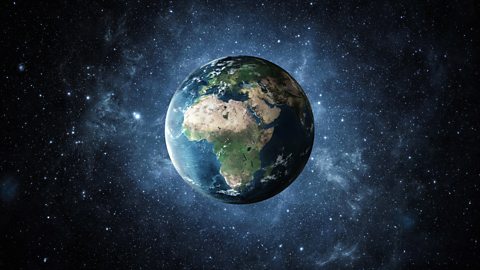
What is the universe?
In short, the universe is everything. It is everything we can touch, feel, sense, measure or detect. It includes all of space, and all the matter and energy in space. It even includes time, and it includes you too.
No one knows the exact size of the Universe because we cannot see the edge! However, the Universe has not always been the same size. It is bigger today than yesterday and it will be bigger still tomorrow- it is expanding.
Scientists believe it began in a Big Bang, which took place nearly 13.8 billion years ago. Since then, the Universe has been expanding outward at very high speed.
What is a galaxy?
A galaxy is a huge collection of gas, dust, and billions of stars and their solar systems, all held together by gravity.
Our Sun is in a spiral galaxy called the Milky Way. It is about half-way from the centre of the galaxy, on one of the arms.
The Milky Way contains about 100 000 million stars. The universe is thought to contain 200 000 million galaxies, each with 100 000 million stars Thats a lot of stars!
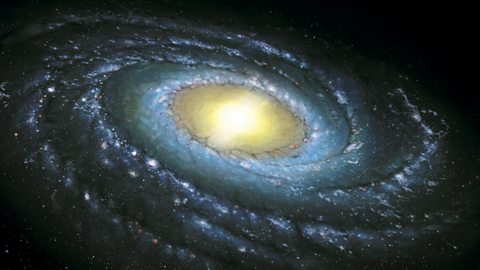
Some galaxies are spiral-shaped like ours. Other galaxies are smooth and oval shaped. TheyÔÇÖre called elliptical galaxies. And there are also galaxies that arenÔÇÖt spirals or ovals. They have irregular shapes and look like blobs. The light that we see from each of these galaxies comes from the stars inside it.
Types of galaxies
- Image source, X-ray: NASA/CXC/SAO; Optical: Detlef Hartmann; Infrared: NASA/JPL-Caltech
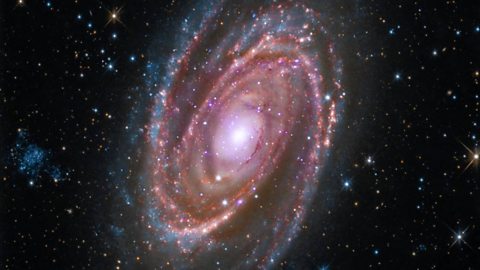
Image caption, A spiral galaxy
- Image source, NASA, ESA, and The Hubble Heritage Team (STScI/AURA)
Image caption, An elliptical galaxy
- Image source, NASA, ESA; acknowledgment: T. Robert, D. Calzetti and the LEGUS Team, R. Tully and R. Chandar
Image caption, An irregular galaxy
1 of 3
When you look up at stars in the night sky, youÔÇÖre seeing other stars in the Milky Way. Due to the EarthÔÇÖs position inside the Galaxy, we see the stars of the other arms of the Milky Way as a band arcing across the sky. In the UK we are looking towards the centre of the galaxy and the evenings of autumn, well away from any sources of light, are the best time to view this awesome sight.


What is a star?
A star is a massive ball of extremely hot gas, which is mainly hydrogen. The temperature and pressure are so high that a nuclear reaction, called nuclear fusion occurs. As a result, enormous amounts of light and heat energy are given off and the star glows.
Our Sun is a star ÔÇô a big ball of mainly hydrogen gas. It is the closest star to Earth and is 150 million kilometres away! Compared to other stars, our Sun has medium mass, medium brightness and medium length of life. ItÔÇÖs a fairly average star!
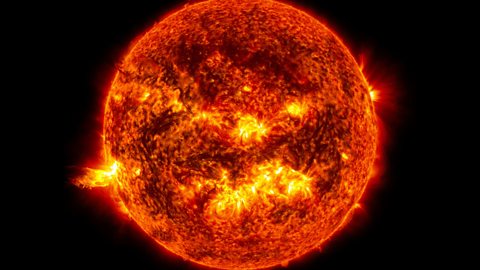
The temperature at the surface of the Sun is about 5600 ┬░C. The temperature rises from the surface of the Sun inward towards the very hot centre of the Sun where it reaches about 15 000 000 ┬░C.
At these temperatures, the atoms of hydrogen and the other gases lose their electrons leaving a mixture, like a soup, of charged particles. These are negatively charged electrons and positively charged ions. This soup is called a plasma and following on from solids, liquids and gases is the fourth state of matter.
Learn about the Sun and other stars.
What is a nebula?
Stars like our Sun are originally formed from a nebula. A nebula is a giant cloud of mainly hydrogen gas and dust in space. Gravity pulled a lot of the gas and dust together and a protostar formed. Temperature and pressure increased further. When the temperature was high enough, nuclear fusion began, and our Sun was born and glowed in the sky.
In a nuclear fusion reaction:
- hydrogen nuclei fuse together to form helium nuclei.
- energy is released and radiates outwards as heat, light and other electromagnetic waves.
What is a solar system?
A solar system consists of a star at the centre, with planets and moons as well as smaller objects such as asteroids and comets in orbit around it.
Our solar system is made up of the Sun, eight planets, moons, asteroids and comets. 99.8% of the mass of our solar system is contained in the Sun!
Learn about the Solar System.
The planets
Starting with Mercury, which is the closest to the Sun, the planets are:
- Mercury
- Venus
- Earth
- Mars
- Jupiter
- Saturn
- Uranus
- Neptune
This mnemonic is a way to remember the correct order:
My Very Easy Method Just Speeds Up Naming
- The four inner planets, Mercury, Venus, Earth and Mars, are small, dense, rocky planets, close to the Sun.
- The four outer planets, Jupiter, Saturn, Uranus and Neptune, are large balls of gas, far away from the Sun.
- The planets and the rest of our solar system are made from what remained of the nebula after the Sun was born.
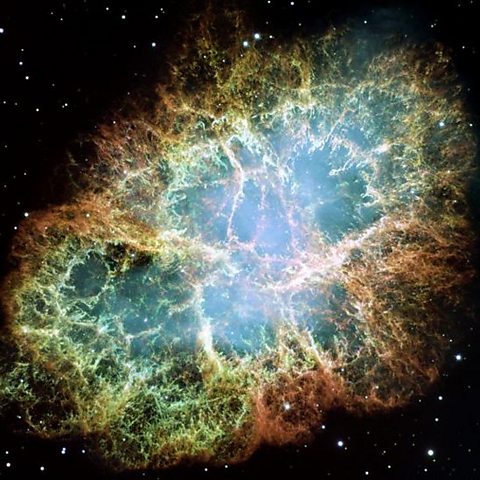
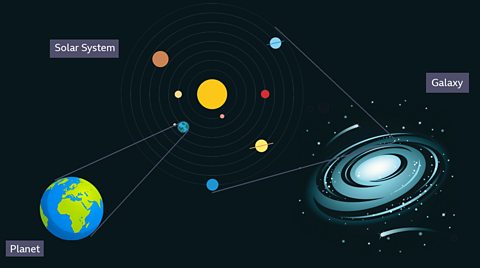
Pluto and the dwarf planets, asteroids and comets
Scientists have discovered other objects orbiting the Sun. These include comets, asteroids, and dwarf planets like Pluto and Ceres. Pluto used to be considered the ninth planet in our solar system, but in 2006 scientists reclassified it as a dwarf planet.
Asteroids and comets have a few things in common. They both orbit our Sun, and they both can have unusual orbits, sometimes straying close to Earth or the other planets. They are both "leftovers" from when our solar system formed. But there are a few notable differences between these two objects, as well.
The biggest difference between comets and asteroids is what they are made of:
- Asteroids are large lumps of metals and rock that orbit the Sun.
- Comets are smaller and made up of ice, dust and rocky materials.
When comets get closer to the Sun, they lose material with each orbit because some of their ice melts and turns into vapour. We see this as the cometÔÇÖs tail. This is another difference between asteroids and comets; comets have "tails" while asteroids generally don't.
A meteoroid is a much smaller rock or particles in orbit around the Sun. If a meteoroid enters the Earth's atmosphere and vaporizes, it is called a meteor, which is often referred to as a shooting star. Of course, it is not a star, just a very hot piece of rock!
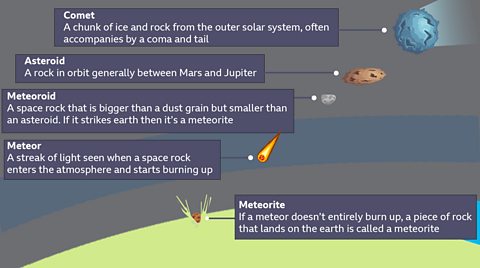
Satellites
A satellite is an object in orbit around a planet. The Moon is the EarthÔÇÖs only natural satellite, but humans have launched many artificial satellites into orbit.

Artificial satellites are used for:
- communications ÔÇô satellite television and phone calls.
- observing the Earth - including weather forecasting, tracking storms and pollution, spying and satellite photography.
- navigation - including the Global Positioning System (GPS).
- astronomy ÔÇô looking into outer space from our solar system.

Listen to Tom Kerss, Astronomer at the Royal Observatory Greenwich, talk about satellites
Two ÔÇ£famousÔÇØ artificial satellites
The International Space Station (ISS) is an artificial satellite. At about the size of a football pitch from end-to-end, it is the biggest object ever flown in space. It is as big inside as a house with five bedrooms, two bathrooms, a gymnasium and a big bay window. Six people can live there. It travels around the Earth at an average speed of 17 200 miles per hour (or 27,700 km/h), flying round the world 16 times every day. At night it can easily be seen from Earth with the naked eye, as it flies nearly 200 miles (or 320 kilometres) above us.
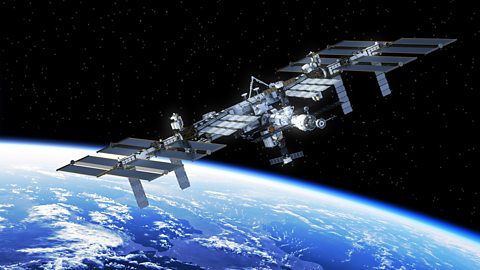
The Hubble Space Telescope is an artificial satellite. It is an unmanned space observatory that allows astronomers to get a better view of objects in outer space than they can get from Earth. It takes photographs of planets, stars and galaxies and sends them back to Earth. The 12 200 kg telescope was placed into a 350 mile (or 570 km) high orbit around Earth by the Space Shuttle, Discovery, in April 1990. It orbits Earth every 95 minutes, travelling at a speed of 17,000 mph (or just over 27,000 km/h).
Summary
Universe: the universe is everything. It is everything we can touch, feel, sense, measure or detect.
Galaxy: a galaxy is a huge collection of gas, dust, and billions of stars and their solar systems, all held together by gravity.
Nebula: a nebula is a giant cloud of mainly hydrogen gas and dust in space. A star and the rest of a solar system form from a nebula.
Star: a star is a massive ball of extremely hot gas, which is mainly hydrogen. The temperature and pressure are so high that a nuclear reaction, called nuclear fusion occurs. Our Sun is a star.
Solar system: a solar system consists of a star at the centre, with planets and moons as well as smaller objects such as asteroids and comets in orbit around it.
Planet: a planet is smaller than a star and is either a small ball of rock e.g., the Earth or a large ball of gas e.g. Jupiter
An easy mnemonic to remember the order of the planets: My Very Easy Method Just Speeds Up Naming.
Satellite: a satellite is an object in orbit around a planet e.g., the Moon, or artificial satellites such as the International Space Station.
Asteroid: an asteroid is a large lump of metals and rock that orbits the Sun.
Comet: a comet is a smaller lump of ice, dust and rocky material that orbits the Sun.
The force of gravity
Gravity is the force of attraction which acts between all objects that have mass.
It is an invisible force, pulling all objects with mass toward each other. The Earth's gravity is what keeps you on the ground and what makes things fall.
The size of the force of gravity between two objects depends on two things:
- the mass of each object - the bigger the mass the bigger the force gravity
- the distance between the objects - the smaller the distance between the objects the bigger the force gravity. Gravity gets weaker as distance increases
Although every object (including you!) has a gravitational pull, it is only really seen in action if one of the objects is really, really massive. The Earth, for example, is big enough to have sufficient gravity to pull you down and to hold the Moon in its orbit. The Sun is massive enough to keep the planets in orbit.

Albert Einstein described gravity as a curve in space that wraps around an objectÔÇösuch as a star or a planet. The more massive the object, the greater the curve in space. If another object is nearby, it is pulled into the curve.
Gravity is everywhere
The force of gravity acts across the entire universe.
- Gravity holds the planets in orbit around the Sun.
- Gravity keeps the moon in orbit around Earth.
- Gravity holds down our atmosphere and the air we need to breath.
- The gravitational pull of the moon pulls the water in seas and oceans towards it, causing the tides ÔÇô you can find out more about the tides here.
- Gravity causes stars and planets to form by pulling together the material from which they are made.
- Gravity not only pulls on mass but also on light.
- Black holes have so much mass in such a small volume that their gravity is strong enough to keep everything, including light from escaping. Since no light escapes, they cannot be seen and that is why they are called black holes.
The gravitational force always pulls towards the centre of any object. So, we are always pulled by gravity towards the centre of the Earth.
The force of gravity between an object and the Earth isnÔÇÖt quite the same everywhere on Earth.
The force of gravity on the top of a mountain is slightly less strong than at the bottom.
The distance from the centre of the Earth is greater on top of the mountain and gravity gets weaker as distance increases. So, the force of gravity is slightly less on top of Slieve Donard than at the bottom.
Also, gravity is slightly stronger over places with more mass underground than over places with less mass.
The distance from the centre of the Earth is greater on top of the mountain and gravity gets weaker as distance increases. So, the force of gravity is slightly less on top of Slieve Donard than at the bottom.
Also, gravity is slightly stronger over places with more mass underground than over places with less mass.
NASA uses two spacecraft to measure variations in EarthÔÇÖs gravity. These spacecrafts are part of the Gravity Recovery and Climate Experiment (GRACE) mission.
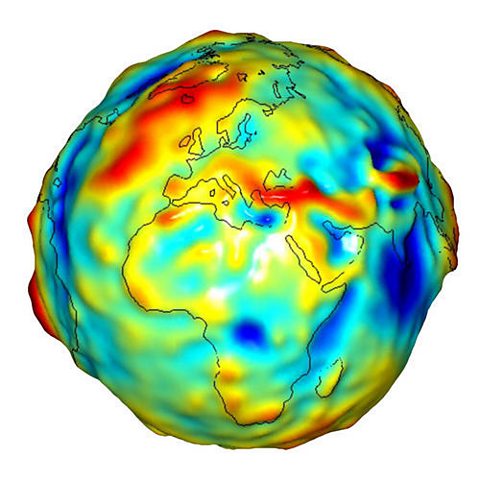 Image source, NASA/JPL/University of Texas Center for Space Research.
Image source, NASA/JPL/University of Texas Center for Space Research.GRACE detects tiny changes in gravity over time. These changes have revealed important details about our planet. For example, GRACE monitors changes in sea level and can detect changes in the EarthÔÇÖs crust brought on by earthquakes.
 Image source, NASA/JPL/University of Texas Center for Space Research.
Image source, NASA/JPL/University of Texas Center for Space Research.Listen to Tom Kerss, Astronomer at the Royal Observatory Greenwich, talk about why humans weigh less on the Moon
Mass and weight
Weight and mass
In everyday life, the terms mass and weight are interchangeable. We often talk about the weight of something when we actually mean its mass. In physics mass and weight do not mean the same and scientists are very clear about the difference.

- Mass is a measure of the amount of matter in an object.
- The more matter an object contains, the greater its mass.
- Mass is measured in kilograms (kg).
- Mass is measured using scales or a top pan balance.
- Mass depends on the size of the atoms that make up a substance.
- The mass of an object is the same everywhere ÔÇô a 5 kg mass doesnÔÇÖt lose any matter if it is taken to the moon and so it has a mass of 5kg on the moon, in space and on the Earth.

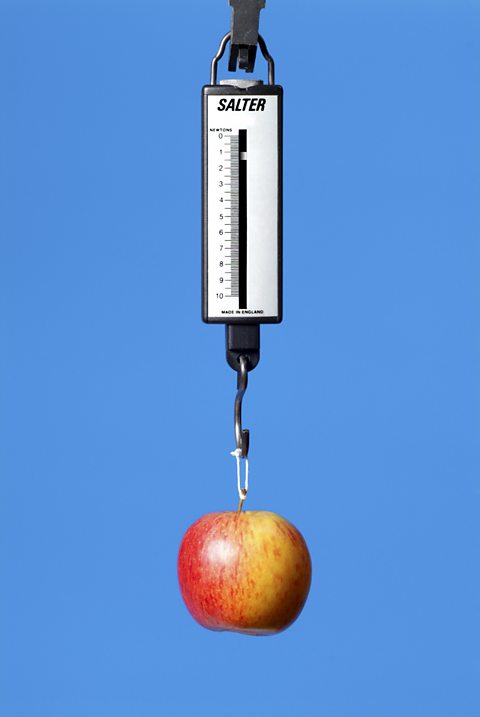
- Weight is the size of the force of gravity acting on an object.
- Weight is a force and so is measured in newtons (N).
- Weight is measured using a newton spring balance.
- The weight of an object is not the same everywhere because the size of the force of gravity is not the same everywhere ÔÇô the force of gravity is less on the moon than on the Earth, so, the weight of the object is less on the moon than on the Earth.
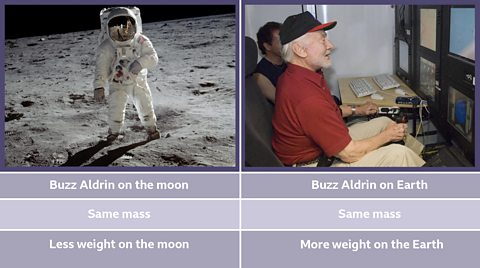
Mass is the same everywhere in the universe.Weight changes from place to place as the strength of gravity changes
Is there a link between weight and mass?
Use a spring balance to measure the weight of different masses. Record your results in a suitable table. Use your results to plot a graph of weigh in N on the y-axis against mass in kg on the x-axis.
Results
| Mass in g | Mass in kg | Weight in N |
|---|---|---|
| 100 | 0.1 | 1 |
| 200 | 0.2 | 2 |
| 300 | 0.3 | 3 |
| 400 | 0.4 | 4 |
| 500 | 0.5 | 5 |
| 600 | 0.6 | 6 |
| 700 | 0.7 | 7 |
| 800 | 0.8 | 8 |
| 900 | 0.9 | 9 |
| 1000 | 1.0 | 10 |

Conclusion
From the results it is clear that on Earth the weight in N is ten times the mass in kg.
10 N/kg is the strength of gravity on the surface of Earth. The proper name for this is the gravitational field strength. The letter used to represent gravitational field strength is g. It is the force of gravity on a mass of 1 kg.
Gravitational field strength, g = 10 N/kg.
On the moon, the gravitational field strength, g = 1.6 N/kg.
Calculating weight
The equation to calculate weight in newtons is:
Weight = mass x gravitational field strength
W = mg
W = weight in N
m = mass in kg
g = gravitational field strength, 10 N/kg (on theEarthÔÇÖs surface)
Remember the mass must be in kg!
This equation can be rearranged to calculate mass, m:
m = \(\frac{W}{g}\)
or gravitational field strength, g:
g = \(\frac{W}{m}\)
Example
Find the weight of a person on Earth if they have a mass of 52 kg (g = 10 N/kg).
Answer
W = mg
W = ?
m = 52 kg
g = gravitational field strength, g = 10 N/kg
W = 52 x 10
W = 520 N
The weight of the person is 520 N.
Example
A school bag has a weight of 43 N. Calculate the mass of the bag (g = 10 N/kg).
Answer
m = ?
W = 43 N
g = gravitational field strength, g = 10 N/kg
m = \(\frac{W}{g}\)
m = 43 ├À 10
m = 4.3 kg
The mass of the bag is 4.3 kg.
Example
A girl has a mass of 45 kg on Earth.
- Find her weight on the Earth, where g = 10 N/kg
- Find her weight on the Moon, where g = 1.6 N/kg
- What is her mass on the moon?
Answer
- On the Earth
W = mg
W = ?
m = 45 kg
g = gravitational field strength g = 10 N/kg
W = 45 x 10
W = 450 N
The weight of the girl on the Earth is 450 N
- On the Moon
W = mg
W = ?
m = 45 kg
g = gravitational field strength g = 1.6 N/kg
W = 45 x 1.6
W = 72 N
The weight of the girl on the Moon is 72 N.
- The mass of the girl is the same on the Earth and the Moon because the amount of matter in the girl is the same in both places. The girl's mass on the moon is 45 kg.
Now try these:
Question
Calculate the weight of a person on Earth if they have a mass of 60 kg (g = 10 N/kg)
W = mg
W = ?
m = 60 kg
g = gravitational field strength g = 10 N/kg
W = 60 x 10
W = 600 N
The weight of the person is 600 N.
Question
What is the mass of a person who weighs 120 N on the Moon (g = 1.6 N/kg)?
m = ?W = 120 Ng = gravitational field strength g = 1.6 N/kg
m = \(\frac{W}{g}\)
m = 120 ├À 1.6
m = 75 kg
The mass of the person on the Moon is 75 kg
Summary
Gravity is the force of attraction which acts between all objects that have mass
Einstein described gravity as a curve in space that wraps around an object
The size of the force of gravity between two objects depends on the mass of each object and their distance apart
Mass is a measure of the amount of matter in an object
Mass is measured in kg using scales or a top pan balance
Weight is the size of the force of gravity acting on an object
Weight is measured in newtons, N, using a newton spring balance
Gravitational field strength, g, is the force of gravity on a mass of 1 kg
On Earth g = 10 N/kg
Mass is the same everywhere in the universe. Weight changes from place to place as the gravitational field strength changes
W = mg
Years and seasons
The Earth and the other planets rotate around the sun in an anticlockwise direction.
A year
- A year is the time it takes a planet to make one complete orbit around the Sun.
The Earth goes once round the Sun in one Earth year, which takes 365.25 days.
Seasons
The Earth's axis is the imaginary line through the centre of the Earth between the South and North poles about which the Earth rotates. This axis is tilted compared with the way the Earth orbits the Sun ÔÇô at an angle of 23.5 degrees.
We get different seasons (winter, spring, summer and autumn) because the EarthÔÇÖs axis is tilted.
The Earth's axis is tilted as it travels around the Sun, so some parts of the Earth receive more sunlight each day than others.
This changes during the year because the Earth orbits the Sun, which gives rise to the seasons.
The UK is in the top half (northern hemisphere) of the Earth. When the northern hemisphere is tilted towards the Sun it is summer in the UK.
Six months later the northern hemisphere is tilted away from the Sun and it is winter.
Spring follows winter and autumn follows summer, but the Earth is neither tilted towards or away from the Sun.
Summary
- it is summer in the UK when the Northern Hemisphere is tilted towards the Sun.
- it is winter in the UK when the northern hemisphere is tilted away from the Sun.
- when the Northern Hemisphere is neither tilted towards or away from the Sun it is spring or autumn.
- if the earth wasnÔÇÖt tilted, we wouldnÔÇÖt have any seasons ÔÇô it would always be like spring or autumn.
Days and nights
Days and nights
A planet spins or revolves on its axis as it orbits the Sun.
- A day is the time it takes for a planet to spin once on its axis.
The Earth takes 24 hours to spin once on its axis and so one earth day is 24 hours.
The Sun lights up one half of the Earth, and the other half is in shadow. As the Earth spins, we move from shadow to light and back to shadow and so on. It is daytime in the UK when our part of the planet is lit by the Sun. And it is night in the UK when our part of the planet is facing away from the Sun.
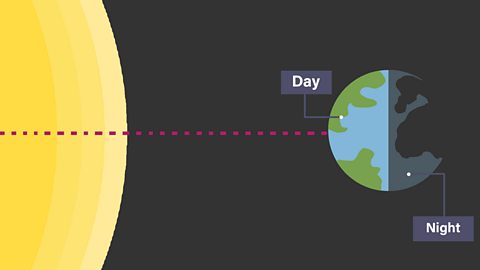
Length of daylight
The difference in the length of daylight from summer to winter is also due to the tilt of the Earth.
- In winter, the UK in the northern hemisphere is tilted away from the Sun. As the Earth spins on its axis, we spend more time in the shadow than in the light and nights are longer than days.
- In summer, the UK in the northern hemisphere is tilted towards from the Sun. As the Earth spins on its axis, we spend more time in the light than in the shadow and days are longer than nights.
- The equator is neither pointed towards or away from the Sun at any time of the year. There are 12 hours of daylight and 12 hours of darkness. Every day all year round.
As the Earth cycles around the Sun, the length of day and night change
Why is knowing about the seasons and daylight length useful?
Farmers know that crops will only grow if there is enough light and if it is warm enough. So, they plant seeds in the springtime as the weather is getting warmer and the longer daylight helps the plants grow over the summer. Knowledge about the seasons and length of daylight are also useful when planning holidays!
Discover how farmers need to understand the seasons in order to grow food
Path of the sun
During the day, the Sun appears to move through the sky. Remember that this happens because the Earth is spinning on its axis.In the UK, if we look south and follow the path of the Sun in the sky during the day, it looks like this:
The Sun appears to move from east to west. This is because the Earth turns anticlockwise from west to east. The Sun appears to:
- rise in the east
- set in the west
- be due south at midday
One way to remember which way the Earth turns is to remember ÔÇÿWE spinÔÇÖ, which means that we (the Earth) spins from West to East.
Path of the Sun at different times of the year
The length of the day (the time when the Sun shines on a particular part of the world) changes during the year, unless you are on the equator.Everywhere else, daytime is longest in the summer and shortest in the winter. In winter, the Sun still appears to rise in the east and set in the west, but it does not climb so high in the sky as it does in the summer.
Summary
Day: A day is the time it takes for a planet to spin once on its axis. An Earth day is 24 hours.
Year: A year is the time it takes a planet to make one complete orbit around the Sun. An Earth year is 365.25 days.
Seasons: occur because the Earth is tilted on its axis and it is orbiting the Sun.
Northern hemisphere tilted towards the Sun ÔÇô summer.
Northern hemisphere tilted away from the Sun - winter.
Length of daylight: long in summer, short in winter because the Earth is tilted on its axis.
More on Physics
Find out more by working through a topic
- count1 of 8
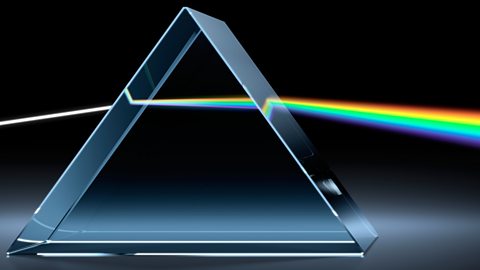
- count2 of 8

- count3 of 8
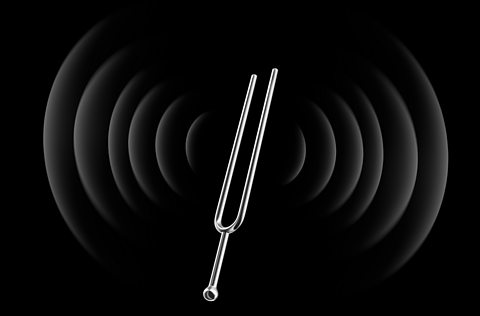
- count4 of 8
